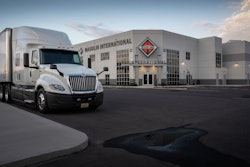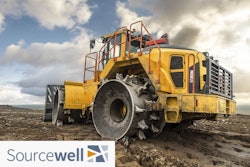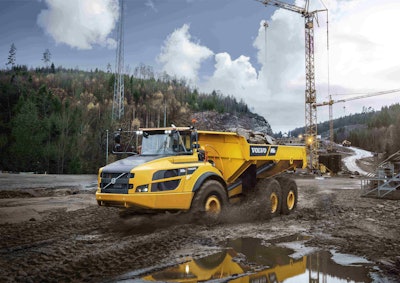
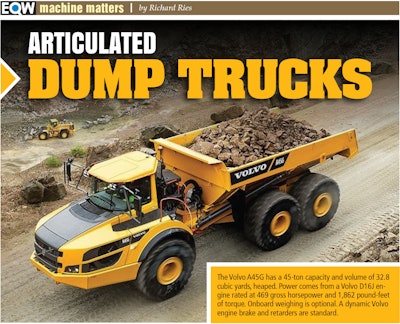
Articulated dump trucks, with their ability to efficiently move dirt throughout the jobsite, are in high demand these days. Dealers report they can’t keep them in their rental fleets, and customers are scrambling to find someone, anyone, who can meet their need for artics.
While there have been steady technological advancements, the “wow” factor isn’t as high with ADTs. They keep doing what they’re doing, and contractors keep using them.
“Other equipment has apparent technology,” says Scott Thomas, product application specialist, Caterpillar. “With ADTs it’s, ‘Yeah, OK, so it has payload,’ and the conversation ends there. With ADTs, most of the technology is behind the scenes.”
Thomas says Cat has had traction control since 2011; six sensors monitor wheel slip and adjust torque accordingly. Cat also has stability control on all but the 725C2, their smallest model. Auto-retarding has multiple levels and will also apply the service brakes if additional braking is needed. Lift assist gives fingertip control to the dump cycle. Hit the switch when traveling under 4 mph in either forward or reverse and the system shifts to neutral, applies the service brakes for a controlled stop, raises engine rpm and raises the bed. The switch is on the joystick right next to the transmission controller to minimize operator distraction. “It’s as simple as raising a power window in a pickup truck,” says Thomas.
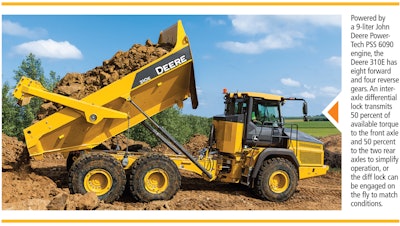
Some technological advances have been small but steady, explains Mark Shea, product consultant, ADTs, John Deere. “Our telematics system, JDLink, is fully configured as it is but still sees regular, incremental advances.” Mostly this means acquiring more data more often and doing more with it. “We want to provide our customers with the best usable data to help them make decisions and minimize downtime,” says Shea. Other behind-the-scenes technology includes axle temperature monitoring and flow control to cool only the axles that need it and a hydraulically driven cooling fan with a reversing option that responds to the demands of the cooling system.
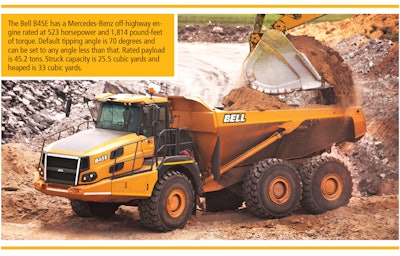
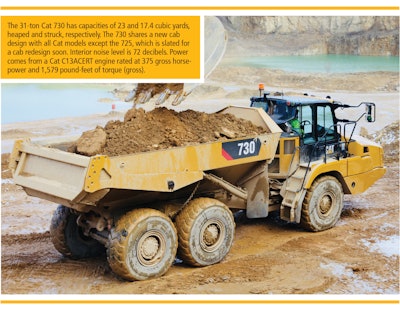
Whoa
Manufacturers have put a lot of work into slowing and stopping ADTs.
Deere E Series trucks began arriving in 2012. The large frame trucks (370E, 410E and 460E), which use Deere axles, have inboard-mounted brakes. The 260E and 310E, which use ZF axles, retain outboard brakes. All axles offer pressurized lubrication along with cooling and individual filtration systems. Deere opted for a transmission retarder rather than engine braking; the retarder offers consistent performance at all engine speeds and can be set for 10 to 100 percent application in 10 percent increments. Stepping on the brake pedal automatically engages 100 percent operation of the retarder to reduce wear on the service brakes. Hill descent control is infinitely variable and serves to maintain truck speed when the operator’s foot is off the brake and accelerator.
The Doosan DA30-5 had its retarder preset available through the in-cab touchscreen monitor. That was fine if the same preset was the right preset throughout the jobsite, but that’s often not the case. So Doosan moved the controller to the joystick where the operator can easily change the percentage of retarder function to match changes in conditions. The presets remain 25, 50 and 75 percent.

Transmissions
While much attention is given to transmission retarders, there have been improvements to transmissions’ other task, as well: to drive the truck. Volvo brought their OptiShift technology over from their wheel loaders to their ADTs from the A25G through the A45G. Popular on Volvo wheel loaders for years, OptiShift technology is now available on this range of articulated haulers.
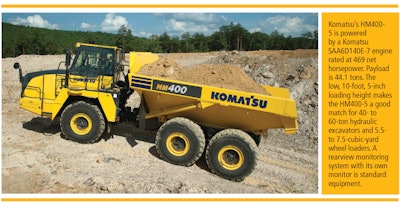
Bell trucks all have FuelSense 2.0 transmission control with equation-based shifting. “As the name implies,” says Paynter, “the transmission varies shift points to match conditions for improved performance and better fuel efficiency.” He says the trucks often shift at a lower rpm than the operator may have. This is similar to the concept of progressive shifting to maximize fuel savings, which has long been a tool of over-the-road drivers rewarded for their fuel-efficient driving habits. Progressive shifting, sometimes called short-shifting, is the practice of moving to the next highest gear so that the engine is at peak torque after the shift.
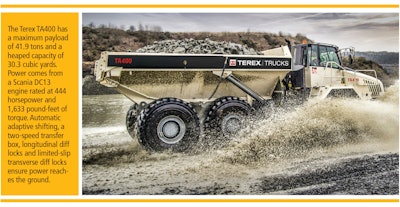
Robert Franklin, Terex Trucks sales and marketing director, Americas, says the company’s larger truck, the TA400, is in high demand due to the number of large infrastructure projects in the United States. “The way things are going in America, ‘the land of opportunity’ is becoming ‘the land of construction.’”
Volvo has also optimized shifting with Volvo Dynamic Drive, which responds to both the payload and the slope gradient. The system will automatically detect when to choose a higher starting gear or when to shift up earlier. When conditions require, it will hold a gear, ensuring maximum rim-pull. “With Dynamic Drive, customers can expect a 3 to 10 percent fuel efficiency improvement depending on the model,” says Rob Palermo, articulated hauler product manager, Volvo.
Comfort and convenience
Doosan is among the manufacturers improving ADT comfort and convenience. The cab of the DA30-5 has more than a dozen new features, including a redesigned dashboard with soft-touch covering, a new monitor with bigger indicators that are easier to read, electrically adjustable mirrors and more space between the foot pedals.
Thomas said Caterpillar held a cab conference in which a dozen seasoned operators from around the world tried design changes using virtual reality in real time. A number of changes emerged from that conference and other research. The cab used to have a 3-inch offset to the left of the centerline of the truck; it is now centered. In-cab storage has an HVAC vent plus a slightly sloping floor to keep things from rolling around all day. The access panel that holds the master shutoff switch, jumpstart connections and other components now also has a wake-up switch.
While the truck can be started cold, Cat recommends engaging the wake-up switch first, so the various computer components can initialize communication before startup. By the time the operator climbs into the cab, the truck is ready to start. Pressing the switch also illuminates the ladder, as does opening the door.
Shea says simple changes can make a big difference. For example, the daily inspection areas on Deere ADTs are illuminated and can be accessed from the ground. Pressure test ports are grouped and offer easy access. Systems are color-coded. Oil, for example, is marked yellow, so the dipstick, filler and sample port are all yellow.
Frank Nyquist, product marketing manager, Komatsu America, says operators benefit from such standard features as a heated operator’s seat with air suspension, adjustable damping and lumbar support, and tilt and telescoping steering. Service personnel appreciate the access provided by the hydraulically powered tilt cab and the convenience of the electric fuel priming pump, which speeds fuel filter changes. Fleet managers derive value from standard Komtrax telematics and from Komatsu Care, which covers scheduled maintenance up to three years or 2,000 hours, whichever occurs first.



